
From the vibrant colors and culture of Colombo to the peaceful hillsides of Kandy, Sri Lanka is both a tea lover’s and traveler’s paradise. Formally known as Ceylon, this South Asian Island in the Indian Ocean is located 20 miles (32 kilometers) southeast of India. Its stunning beaches, exotic wildlife, and rich history provide the ideal setting for a journey of discovery.
In 2017, Sri Lanka celebrated the 150th anniversary of Ceylon tea with a series of events and memorabilia highlighting the taste, history, and innovations associated with this tea. Sri Lanka is remarkably suitable for growing a variety of teas. Seasonal differences across Sri Lanka bring forth an array of aromas, flavors, and colors from the full-bodied cup from Kandy to the exotically aromatic UVA tea that Sir Thomas Lipton first introduced to America.
“The 26 sub-districts each have their own characteristics including elevation, climate, type of cultivar, and methods of cultivation, providing unique offerings to the consumer unmatched by any other producer,” says Spencer Manuelpillai, senior brand marketing manager at Dilmah Tea.
On the 150th anniversary of Ceylon tea, Sri Lanka deserves praise not only for the quality of its tea but for its investments in sustainability and innovations in blending and packaging. Proud of both its history and future, the events began early this year with the unveiling of the bust of James Taylor, and a tea exhibition at the Priory house in Dunstable, Bedfordshire, UK, that reveals the entire history of how Taylor pioneered commercial production to save the country from financial ruin.
From bean to leaf
The tale of Ceylon begins strangely enough, with coffee. Cultivation peaked in 1870 with more than 275,000 acres (111,000 hectares) making it one of the top three coffee producing regions in the world.
The Dutch introduced coffee during the 1850s and the coffee cherry flourished in the hills of Ceylon, attracting interest and investment from the British colonies. It was nicknamed the “coffee rush.” One such individual was a Scotsman, James Taylor, who arrived the country in 1852 to work at a local coffee plantation. A hard worker, Taylor was put in charge of the Loolecondera Estate, where he diligently cultivated this precious crop.
An innovator, Taylor traveled to India to research tea cultivation and processing. Curious if this crop would thrive in Sri Lanka, Taylor brought back some seeds and planted them on a small plot at the estate. Little did he know that this new crop would be the country’s salvation.
In the 1880s, “Devastating Emily,” a fungal epidemic known as coffee leaf rust, wiped out 90 percent of the country’s coffee trees leaving only 11,000 acres unharmed. Meanwhile, Taylor’s tea plants were thriving. During this period, Taylor processed the leaves with his own factory and machinery and sent his first tea sample to the London Tea Auction in 1875. By that time there were 26 registered estates. Ten chests filled with tea were offered for sale.
The tea was a hit. In 1884, Ceylon had consigned 2.5 million pounds of tea to London, and three years later, the figure had increased to 15 million. Within a decade, the country returned to prosperity. Tea remained Sri Lanka’s primary source of revenue until the early 1980s. “Thanks to tea we have roads, railroads, and prospering businesses,” said Michael De Zoysa, chairman, Colombo International Tea Convention, Colombo, Sri Lanka.
Over the years, said De Zoysa, Ceylon tea has had an interesting journey, beginning with the massive British-owned plantations including those held by millionaire Thomas Lipton — to the return of small holders and Sri Lankan owned and operated companies. “Thomas Lipton used to call Ceylon his tea garden,” said De Zoysa.
“Ceylon tea has had a fascinating history,” says Mike Bunston, honorable tea ambassador to Sri Lanka, UK. “When I first came into the tea business in 1959, Ceylon accounted for 40 percent of all tea imported into the UK. However; when the tea was nationalized, a lot of things changed. Today approximately 1 percent of tea in the UK is from Ceylon.”
Ceylon tea remains extremely important to the tea industry worldwide. Approximately 70 percent of the tea is grown on small-holder fields, with the Middle East, including Turkey, Iran, Iraq and Russia, their primary trade customers. Today, approximately 68 percent of Sri Lankan tea is exported, mainly for blending in teabags. In the past year Sri Lanka tea achieved the highest average price at auction of any producing country, at $3.06 per kilogram, a slight improvement of last year per-kilo average of $3.04.
Specialty teas present a new opportunity for Sri Lanka to market their distinct orthodox premium leaf in North America and the UK.

The year-long celebrations in-country and abroad are designed to bring attention and renewed interest. Each month there is a new event planned with commemorative stamps marking the start of the year; educational fairs in each of Sri Lankan’s tea-growing regions, and a commemorative book released in June. The major events take place in the summer beginning with a charity auction and then wrapping up with an international conference. The charity auction, which takes place in June, will feature various antique silver tea service, historical tea machinery, auction gavels from the Colombo auction house, decorative scales, and other items reflecting the Ceylon tea industry. Funds will be donated to a variety of Sri Lankan charities.
A global tea party will commence in July with an International Tea Festival infusing the roads of Colombo with tea stalls, food and entertainment that will share tea culture and Ceylon Tea with the community and visitors.
The International Tea Convention, which takes place from August 8 to 11, offers many events, including work sessions, to highlight the technology, innovation, and quest for quality that continue to set Sri Lankan tea apart.
“We hope to have approximately 200 to 300 delegates worldwide with a widespread representation,” said de Zoysa. “We have been told that there will be at least 10 attending from the USA, Canada, UK, and Germany, and we are also hoping for a fairly wide representation from China as they have become a growing market for Ceylon tea.”The convention is followed by the Ceylon Tea Expo which will bring together national and international producers, exporters,
The convention is followed by the Ceylon Tea Expo which will bring together national and international producers, exporters, manufacturers, and importers to share their services and products.
Traveling to the gardens
 Focused on sustainability, Ceylon’s teas are some of the purest teas in the world. All tea grown and processed in Sri Lanka is certified ozone friendly, identified by the “Ozone Friendly Pure Ceylon Tea” logo. “We are proud to share that Ceylon tea is the first, and currently the only, ozone free tea in the world,” said Chaminda Jayawardana, managing director, Lumbini Tea Factory, Sri Lanka. “Our tea is free from all of the ozone harming gasses from the plant to the cup,” he said. He said the industry supports plans to impose a ban on the use of methyl bromide in both shipping and export packaging.
Focused on sustainability, Ceylon’s teas are some of the purest teas in the world. All tea grown and processed in Sri Lanka is certified ozone friendly, identified by the “Ozone Friendly Pure Ceylon Tea” logo. “We are proud to share that Ceylon tea is the first, and currently the only, ozone free tea in the world,” said Chaminda Jayawardana, managing director, Lumbini Tea Factory, Sri Lanka. “Our tea is free from all of the ozone harming gasses from the plant to the cup,” he said. He said the industry supports plans to impose a ban on the use of methyl bromide in both shipping and export packaging.
He said the industry supports plans to ban the use of methyl bromide in shipping and export packaging.
The country has invested in several sustainability initiatives to address this issue. One example is Dilmah’s Tea 2016 research study investigating the applicability and function of biochar, a nutrient-rich soil enhancer, to restore the depleted soil. As part of this study, biochar was applied to several of the Dilmah plantations, including their Rilhena Estate, Kahawatte Plantations, and the Endana Estate. To date, the results have been positive. Early findings suggest biochar will improve both yield and quality of tea.
Sri Lanka has a sophisticated “value-added” capability for deep processing tea into various forms, including solubles and concentrates; advanced fill and packaging capabilities; and blending with close adherence to quality. Specialties include single-source blends using traditional methods, including hand-plucked tea.
This is the year Sri Lanka is hosting a tea party for the entire world.

Visiting Sri Lanka
 The best way to experience the elegance and understand the unique history of Ceylon’s Tea gardens is to visit them. Sri Lanka has opened its heart and doors to tea tourism, welcoming tea lovers and historians to explore their gardens, factories, and museums. Those who travel to the island, which is 272 miles long and 140 miles wide, will enjoy tasting, beautiful views and a stay at one of several tea bungalows, all which offer breathtaking views of tea plantations. Visitors can drop in for a few hours or fully immerse themselves in the experience staying in stylish accommodations on these plantations.
The best way to experience the elegance and understand the unique history of Ceylon’s Tea gardens is to visit them. Sri Lanka has opened its heart and doors to tea tourism, welcoming tea lovers and historians to explore their gardens, factories, and museums. Those who travel to the island, which is 272 miles long and 140 miles wide, will enjoy tasting, beautiful views and a stay at one of several tea bungalows, all which offer breathtaking views of tea plantations. Visitors can drop in for a few hours or fully immerse themselves in the experience staying in stylish accommodations on these plantations.
Several offer short tours including Dambatenne Tea Factory in Haptule, where visitors can learn about tea processing at the factory established by Thomas Lipton, himself. After the tour, take a trek up to Lipton’s seat and experience the spectacular sea of greenery that Lipton himself saw when overseeing his plantation. Halppewatte Tea Factory, in the Uva region, has opened its doors to visitors, providing a step-by-step tour of tea processing and a tea tasting experience at their Sky Café.
For tourists seeking a more hands-on experience, Rickshaw Travel offers tourists a 2-day, 1-night tea experience. Journey to Nuwara Eliya, where you will learn how to pick tea with a local plucker, tour the tea factory, and, of course, wrap up the journey with a tasting. The following day, you will experience the beauty of Sri Lanka’s geography traveling to the Hortons Plain National Park and then wrapping up your journey at World End.
Tea Market
Get More Value from Your Tea: BRU Maker One
+41794574278
Jacque's Organics
(647) 804-7263
i am in,thanks!